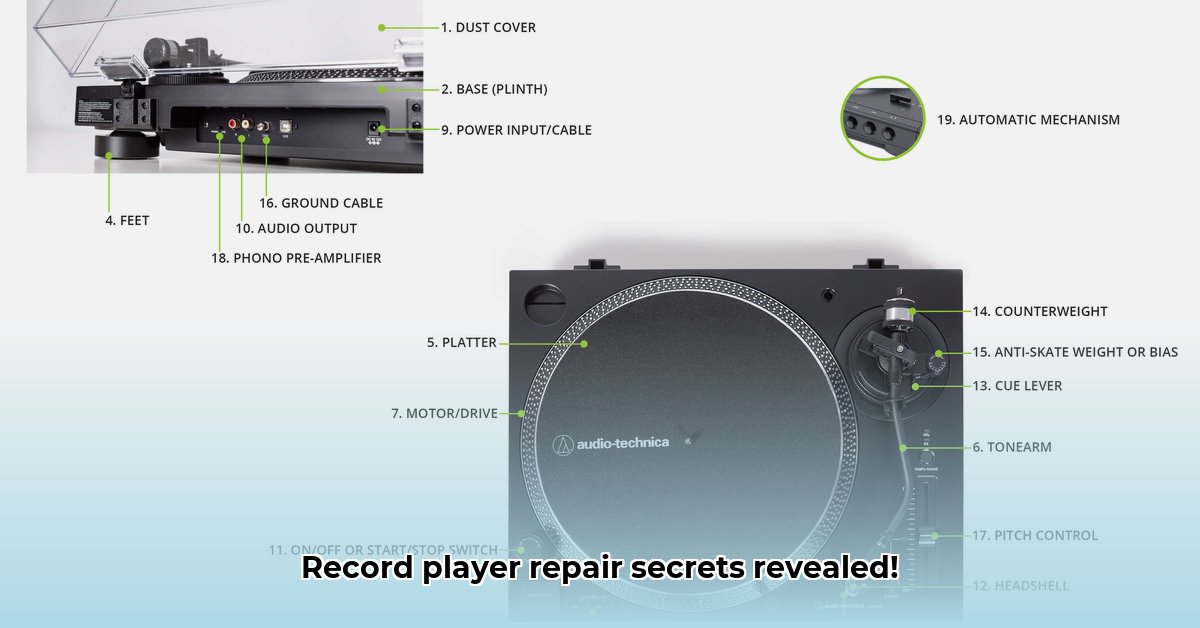Ever wondered what makes your record player work? This guide will take you on a journey inside the world of vinyl, explaining everything from the spinning platter to the tiny needle that reads the grooves. We’ll compare different types of record players, help you set yours up perfectly, and show you how to keep it spinning smoothly for years to come. Whether you’re a seasoned audiophile or just getting started with vinyl, you’ll find helpful advice and tips here to make the most of your record player and your music. For a more in-depth explanation, check out this helpful guide: Record Player Guide.
Record Player Parts: Exploring Vinyl Sound Technology
Spinning vinyl isn’t just about nostalgia; it’s about experiencing music in a uniquely tactile and engaging way. But to truly appreciate the warm, rich sound of a record player, understanding its inner workings is key. This guide dives into the essential components, offering practical advice for everyone from casual listeners to seasoned audiophiles interested in vinyl sound technology.
The Plinth: Foundation of Sound
Think of the plinth, or base, as the foundation of your record player – it’s the sturdy platform that supports all the other parts. Its material directly affects how smoothly the whole system runs and ultimately impacts the sound quality. Imagine it like the sturdy frame of a house – a shaky base leads to problems.
A solid plinth is crucial for minimizing unwanted vibrations. Materials like MDF (Medium-Density Fiberboard), known for its density and damping properties, are commonly used. Wood, especially hardwoods like maple or walnut, can also be excellent choices, offering a balance of stiffness and vibration absorption. More exotic materials like acrylic or constrained-layer damping composites are found in higher-end models, each offering unique sonic characteristics. The plinth doesn’t just sit there; it actively contributes to the sound.
The Platter: Rotation and Stability
The platter, the large, rotating disk, is where the vinyl record resides. Its role is critical: to spin the record at a consistent speed, minimizing vibrations that could muddy the audio. Different materials offer various advantages.
Heavier platters, often made of materials like aluminum or acrylic, provide greater inertia, which helps maintain a constant speed and reduce flutter (small, rapid variations in pitch). Some platters incorporate damping materials to further absorb vibrations. The ideal platter material balances mass, damping, and resonance characteristics to deliver stable and accurate playback. You’ll find platters ranging from lightweight plastic in budget models to hefty, multi-layered designs in high-end turntables.
The Tonearm: Precision Guidance
The tonearm is a delicate yet crucial component in quality record players. It’s the slender arm that holds the cartridge and gracefully glides across the record’s surface, reading the music encoded in the grooves. The design of the tonearm—whether straight, S-shaped, or another configuration—significantly impacts the sound by its ability to minimize unwanted vibrations.
Tonearms are designed to be lightweight and rigid to accurately track the record grooves. Materials like aluminum, carbon fiber, and magnesium are commonly used. The tonearm must also have precise bearings to allow for smooth movement across the record. Key adjustments include tracking force (the downward pressure of the stylus) and anti-skate (which compensates for the inward force caused by the record’s rotation). Proper tonearm setup is essential for optimal sound and minimizing record wear.
The Cartridge: Sound Conversion
The cartridge is the tiny transducer (device that converts one form of energy into another) that transforms the physical vibrations of the stylus in the record grooves into electrical signals—the raw audio that your amplifier and speakers will use to fill the room with music. It’s easily the most crucial element of the sound reproduction process. There are two primary types: Moving Magnet (MM) and Moving Coil (MC).
MM cartridges are generally more affordable and easier to match with phono preamps, making them a popular choice for beginners. MC cartridges, while more expensive, often offer superior detail retrieval and a wider frequency response. The choice between MM and MC depends on your budget, listening preferences, and the capabilities of your phono preamp. Cartridge alignment is also crucial for optimal performance; tools like protractors can help you achieve correct alignment.
The Stylus: Detail Extraction
The stylus, more commonly known as the “needle,” is the tiny point at the end of the cartridge that physically interacts with the grooves in the vinyl record. Think of it as the critical link—it’s essential for capturing and converting the grooves’ indentations into audio signals. This tiny component is a consumable part, meaning it wears down over time and needs replacement.
Styli are typically made of diamond, known for its hardness and wear resistance. Different stylus shapes, such as conical, elliptical, and Shibata, offer varying levels of detail retrieval and groove contact. A worn stylus can damage your records and degrade sound quality, so regular inspection and replacement are essential. The lifespan of a stylus depends on usage and care but is generally between 500 and 1000 hours.
The Motor: Powering Rotation
The motor is the engine of the record player, responsible for rotating the platter at the correct speed (typically 33 ⅓ or 45 RPM). The two main motor types are belt-drive and direct-drive.
Belt-drive systems use a rubber belt to transfer power from the motor to the platter, isolating the platter from motor vibrations and noise. This results in a smoother, quieter sound experience. Alternatively, direct-drive systems directly connect the motor to the platter, providing higher torque (rotational force), making them popular among DJs who require quick starts and stops. The motor’s speed accuracy and stability are crucial for maintaining the correct pitch and tempo of the music.
Drive Systems: Belt vs. Direct Drive: A Comparison Table
| Feature | Belt-Drive | Direct-Drive |
|---|---|---|
| Motor Isolation | Excellent; minimizes motor noise | Poor; motor noise can be audible |
| Torque | Lower; slower startup/stopping | Higher; fast startup/stopping, ideal for DJs |
| Cost | Generally lower | Generally higher |
| Maintenance | Requires belt replacement | Generally more reliable, less maintenance |
| Sound Quality | Often perceived as warmer, quieter | Can be more dynamic but sometimes harsher |
| Typical Use | Home listening, audiophile setups | DJing, scratching |
The Phono Preamp: Amplifying the Signal
The signal produced by a cartridge is very weak and requires amplification before it can be sent to a regular amplifier or receiver. This is the job of the phono preamp. Some turntables have a built-in phono preamp, while others require an external one.
External phono preamps generally offer better sound quality and more flexibility in terms of gain and loading adjustments. These adjustments allow you to fine-tune the preamp to match the specific characteristics of your cartridge, optimizing its performance. The phono preamp is a critical component in the signal chain, and investing in a good one can significantly improve the overall sound of your record player.
Setting Up Your Turntable: Step-by-Step Guide
Setting up your turntable correctly is essential for optimal performance and to prevent damage to your valuable records. Follow these steps carefully:
- Level the Turntable: Use a bubble level to ensure the turntable is perfectly horizontal on a stable surface. This minimizes vibrations.
- Attach the Platter and Mat: Carefully place the platter onto the spindle, and then add the turntable mat, which helps to reduce vibrations and improves grip between the platter and the vinyl.
- Connect the Tonearm: This may require some finesse, potentially involving adjusting the counterweight to balance the tonearm. Consult your turntable’s user manual for precise instructions.
- Connect the Cartridge (if not pre-installed): Properly align and securely attach the cartridge to the tonearm, being mindful of avoiding unnecessary stress or misalignment. Use a cartridge alignment protractor for best results.
- Adjust Tracking Force: The tracking force refers to the amount of downward pressure the stylus exerts on the record. Consult your cartridge’s specifications for the recommended setting. Use a stylus force gauge for accurate measurement. Improper tracking force can induce distortion and cause significant record damage.
- Adjust Anti-Skate: Adjust the anti-skate control to compensate for the inward force on the tonearm. This helps the stylus track the grooves evenly and reduces record wear.
- Connect the Cables: Carefully connect the appropriate audio cables (usually RCA cables) from the turntable to your preamplifier or amplifier, ensuring a secure connection to avoid any interference or hum. Connect the ground wire to the grounding terminal on your preamp or amplifier.
Troubleshooting Common Issues: Tips and Solutions
Even the best record players can encounter occasional issues. Here are some common problems and how to address them:
- Humming Sound: A humming sound often indicates a grounding problem. Check all connections, ground wires, and ensure the turntable is properly plugged into an outlet with a good ground connection. Try a different outlet or a power conditioner.
- Skipping: This can be caused by several factors, including a worn stylus, incorrect tracking force adjustment, or defects on the record itself. Check each of these to correct the issue and avoid record damage. Clean your records regularly with a record cleaning brush and solution.
- Slow or Erratic Speed: Look for a worn belt (in belt-drive setups), ensure that the motor runs freely and to the correct speed, and consider lubricating the motor (if appropriate). Check










